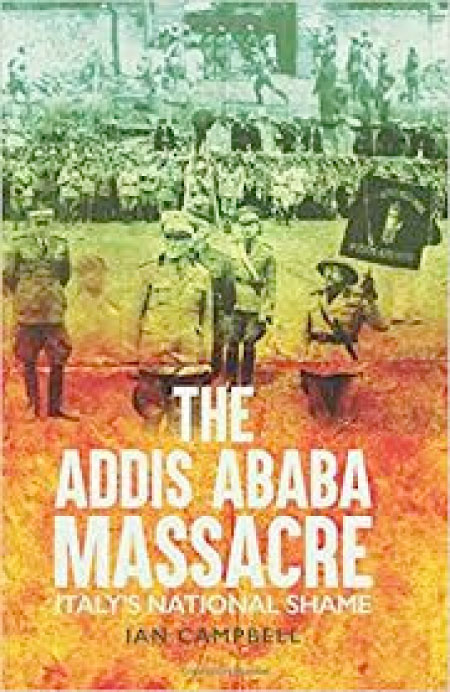
Reviewed by Kapil Komireddi
Italy, at the dawn of the 20th century, was Europe’s poor man. Rome looked with bitterness at its European neighbours. They had vast colonial possessions abroad. Italy, recently unified, was an upstart. Its greatness lay behind it. An intense desire to reclaim what was lost ignited the imaginations of Italy’s most revered luminaries.
Gabrielle D’Annunzio, Italy’s greatest poet and dramatist, exhorted his compatriots to restore their nation’s illustrious past through territorial conquest. His play The Ship mixed sex and violence with an hypnotic message of empire and glory. Its premiere in 1908 culminated with crowds spilling out into the streets chanting the most memorable dialogue from the performance: “Fit out the prow and set sail for the world.”
In 1911, on the 50th anniversary of the country’s founding, Italy proceeded to conquer Libya. Italy’s brutality stands out even in what became the most brutal century in human history. Italian forces in Tripoli, in the words of one observer, went “mad with the lust for blood.
All the Arabs they met, men, women and children, even babes at the breast were shot down without trial." About 4,000 Arabs, it is estimated, were butchered by Italians in Libya over three days in October 1911.
The
zealous rush to restore Italy’s lost greatness through conquest not only
predated fascism by a decade but fascism, it might be argued, grew in part from
the bruised national ego that prompted Italians to impose themselves on
defenceless people in faraway lands.
“Remember,”
the Italian military commander Rodolfo Graziani told his forces as they
“pacified” Libya by rounding up Arabs into concentration camps, “you are
Italians, Romans, and remember that your forebears were once in this country”.
Italy,
in its self-conception, had not only been destitute by virtue of not having an
empire. It had also to confront the humiliating fact that it had been routed by
an African power when it set out to build an empire in the 19th century.
Italy’s military defeat in 1896 to Ethiopia was a special wound in the long
list of grievances that underpinned its renewed search for grandeur on the
world’s stage. This time, it made extensive preparations before advancing on
Ethiopia.
It
built a chemical weapons factory on 30 acres of land near Mogadishu in Somalia.
The quantities of lethal gases produced at that facility were so large that no
fewer than 17 warehouses had to be propped up to store them. The Italians
stockpiled 35,000 gas masks for their own safety.
Ethiopians
stood no chance as the Italians showed up in 1935. They were gassed on the
ground and strafed from the skies. Ethiopia was overwhelmed. Bruno Mussolini,
son of the Duce, wrote newspaper articles about clusters of Ethiopians
“bursting open like a rose” when bombed from above. He admitted to finding this
spectacle “most amusing”.
Despite
its savagery, Italy regarded itself as an agent of civilisation in Africa. Tens
of thousands of Ethiopians were exterminated, the journalist George Steer wrote
bitterly, so “that civilisation should prevail”.
Pope
Pius XI congratulated Italians on a “beautiful victory by a great and good
people”. The defeat of 1896 was avenged and Italy now had an empire.
Much
of this history forms the background to The Addis Ababa Massacre: Italy’s
National Shame, Ian Campbell’s blow-by-blow account of the killings supervised
and undertaken by Italian forces in the Ethiopian capital in 1937.
Empire,
Campbell shows in this masterly history, did not temper the bloodlust of
Italians. Ethiopia’s invasion, for all its horrors, had been swift. Its
occupation was a protracted calvary. Ethiopian prisoners were frequently used
for target practice, shot first in the testicles and then in the chest.
Graziani, installed as fascist Italy’s viceroy in Addis Ababa, was under strict
instructions from the Duce to execute all prisoners.
No
self-respecting people could endure the sadism that passed for civilised
governance. And in February 1937, grenades were hurled at Graziani as he
delivered a speech before an Ethiopian audience. Graziani survived. No Italians
were killed. But amid the confusion, Italian soldiers opened fire with heavy
machine guns at the Ethiopian audience.
As
the crowds dispersed, the exits were sealed off. What ensued, Campbell writes,
was a holocaust. This was not a moment of madness. Throughout the day, Italian
soldiers and Blackshirts ran amok in the streets and suburbs of the city. They
split the heads of Ethiopians they captured with pickaxes and shovels. Every
native was a target.
“Men,
women and children were taken unawares and killed indiscriminately and without
explanation. Going home for lunch or stopping for a chat, unsuspecting and
defenceless, they were ruthlessly struck down in broad daylight in the main
streets … among the eucalyptus groves and the hedgerows, around market stalls,
on bridges, in tiny lanes and narrow alleys.”
The
killings were accompanied by loot. Italian Blackshirts made trips to the bank
to cash in the jewellery they seized from their victims. Upper-class
neighbourhoods of Addis Ababa were spared only because Italians coveted the
properties.
More
than 19,000 Ethiopians were killed in Addis Ababa by the time the Italians had
exhausted themselves. (Across Ethiopia, the figure is north of 30,000.)
Eyewitnesses to the massacre gathered ample evidence, including photographs of
Italians posing with severed heads of Ethiopians.
The
English suffragette Sylvia Pankhurst led an heroic effort to indict Graziani
and the Italian apparatus of occupation. It was only when Britain went to war
with Italy that Addis Ababa was liberated and Haile Selassie, the exiled
Ethiopian emperor, made a triumphant return to his capital.
Campbell,
in one of the most affecting passages in this arresting book, contrasts the
magnanimity of the emperor with the conduct of the Italians, many thousands of
whom still lurked around in Addis Ababa.
In
a passionate speech that enumerated the many crimes committed by Italy, the man
cast by Rome as a primitive barbarian urged his people not to “repay evil with
evil”. “Do not indulge in the atrocities which the enemy has been practising,”
he told them. “Take care not to spoil the good name of Ethiopia by acts that
are worthy of the enemy.”
A
militia of 10,000 Ethiopians was among the crowd that listened to emperor
Selassie; they went home without harming a single Italian.
Selassie
sought justice through legal means. His efforts were frustrated by London.
Campbell has unearthed a top-secret letter written by Winston Churchill in
1944, after the fall of Rome, instructing his envoy in Italy to protect Pietro
Badoglio, the man who had gassed Ethiopians and was listed in Addis Ababa’s
dossier of evidence as the top war criminal. The British government headed by
Churchill went to extraordinary lengths to discredit eyewitness accounts of the
Addis Ababa massacre and London eventually thwarted Selassie’s bid for
Ethiopia’s inclusion in the UN War Crimes Commission.
The
British government’s behaviour, in contrast to the solidarity and activism of
its people, was a shameful coda to the story of Italy’s occupation of Ethiopia.
Campbell delicately calls Churchill’s actions “curious”. But the unwillingness
to see white Europeans prosecuted for crimes against black Ethiopians was in
keeping with Churchill’s overall world view. He was an unabashed white
supremacist who mobilised his nation against Nazi Germany, and not, as his
hagiographers relentlessly strive to portray him, a champion of universal
freedom and neutral justice. An early advocate, by his own admission, of “using
poisoned gas against uncivilised tribes”, Churchill would have seen Graziani
and Badoglio as kindred spirits, not embodiments of evil.
The
consequence of Churchill’s prejudice was that no Italian was ever prosecuted
for crimes in Ethiopia. For its part, Italy, far from exhibiting remorse,
clamoured in earnest for sovereignty over Ethiopia. And the United Nations,
rather than throwing out this demand, debated it. And finally, when Italy and
Addis Ababa restored diplomatic relations, the Italians did not feel the need
to apologise for their past.
It’s
as if the occupation of Ethiopia and the massacre of Addis Ababa never
occurred. In 2012, a right-wing mayor in an Italian town erected a statue to
Graziani. It has since become a site of protest, drawing crowds of Italians who
want their country to own up to its record in Africa.
Ian
Campbell has performed a tremendous service by rescuing from historical neglect
and European propaganda the stories of the victims of 20th-century Italy’s
homicidal push for greatness. Eighty years have passed since the massacre of
Addis Ababa. It is still not too late for Rome to make a full apology to
Ethiopia.
Available
at Timbooktoo tel 4494345



